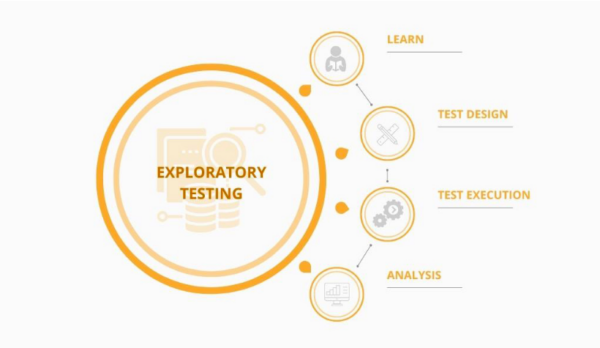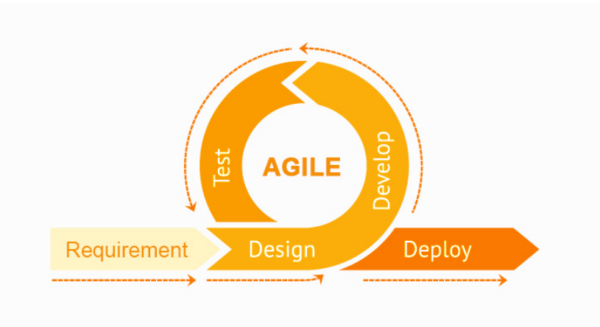Exploratory testing is important to Agile software development. Currently, Agile stands as one of the most popular approaches that every tech company appears to practice for software development. It is due to its evolutionary and flexible nature. It also permits your business to appear a lot more professional.

According to the 2018 report from kiss flow, projects that used Agile methods are 28% more successful, and nearly 71% of companies utilize Agile with changing frequencies no longer going freestyle.
So, What is Agile?
Agile was released in 2001 when 17 technologists drafted the Agile Manifesto for Software development.
To develop a better mobile app or web app, they wrote four essential principles for agile project management:
- Individuals and interactions through testing processes (test automation) and tools: Humans carry out software development. Thus the quality of interaction between them is crucial. Though tools are an essential part of software development, focusing more on teamwork regardless of the team’s tools makes excellent software.
- Working software over thorough documentation: Documentation can be an excellent resource for users and coworkers. But, software development aims to build software that delivers business benefits rather than extensive documentation.
- Customer collaboration through contract negotiation: The software development team liaises with clients frequently. Your team will understand what stakeholders want by listening to and getting their feedback.
- Responding to change by following a test plan: In software development, shifts are a reality that your software process should reflect. A project plan ought to be flexible enough to alter as the different test cases or test scenarios demand.
The authors of the Agile Manifesto picked the word ‘Agile’ for the whole idea. The term represented the adaptiveness and response to change, which was vital to their approach.
Definition of Agile Software Development?

Agile software development cycle
Agile software development references a development cycle process aligned with the Agile Manifesto’s concepts.
Keeping to their values and principles, developers build their software in incremental, rapid cycles instead of delivering it in one sweep near the end.
It consists of test design, testing strategies (regression testing, functional testing, unit testing, manual testing and devops testing), analysis, coding, and product release. It functions by breaking projects down into a little bit of user functionality, prioritizing them, and then delivering them continuously in 2 to 4 cycles called Sprints or Iterations. An entire development lifecycle is performed in one short Sprint (2-4 weeks).
After each Sprint, developers release a working software solution, and the customer evaluates the performance. The lessons learned in individual Sprint are captured in retrospectives and used in successive iterations.
So the following Sprint will be the better version of the prior Sprint. In this way, the products are improved upon constantly and the product development process.It is important to know how the Agile methodology works, just like any other testing method such as Unit Tests.
The Benefits of Agile Development Methodology

Advantages of Employing an Agile Methodology for Software Development
Agile methodology is suitable for businesses looking to transform the way they manage their projects and operate them. It aids teams when they are managing work more efficiently and effectively testing and delivering the best quality product while staying within the budget.
So, if you are a startup interested in developing a web app or a mobile app, approach a reliable team that goes along with Agile methodology. These are the advantages you are going to get:
- High-quality product
- Reduces technical debt
- Increased adaptability
- User-focused testing
- Creates total alignment and transparency
- Reduced risks
- Increased customer satisfaction
- Improves real-time to market
- Early and predictable delivery
- Better project control
High-quality product
When utilizing Agile methods for software development, the development team does not try to develop all features simultaneously. On the other hand, they divide the project into manageable units to focus on high-quality software testing/scrum and agile testing, development, and collaboration. There are numerous advantages to upgrading your software and hardware.
After individual iteration, they conduct test execution and ask for reviews from the product owner, you. This method helps the team identify expectation mismatches in the early stages of development and helps find and fix bugs fast. Working on these incremental releases will make sure that individual iteration results in a thoroughly tested and working product. Thus, the quality of the product is made better.
Reduces technical debt
It refers to the maintenance tasks needed to support the existing product. It includes refactoring, defect resolution, and automated tests.
Agile methodology aids in keeping the technical debt to a minimum. If any changes in defects, features or other maintenance tasks are required, they are added to the “product backlog.”
Prior to each sprint planning testing session, the team reviews the backlog to determine the issues that you should address next. Therefore, each Sprint gives a new opportunity to address defects and new feature development.
Increased adaptability
Adaptability or agility is among the key advantages of Agile because it matters at every level of the organization.
But how does adaptability matter?
When organizations grow, they grow more complex. And it is inevitable! As anything grows more complex, it tends to become slower. Because of the undisciplined changes in the rules of startups in every industry, incumbent players must keep up.
So, to remain competitive, organizations focus on speed; however, speed without a proper strategy and efficiency cannot aid you in building a more efficient system. This is the reason why most organizations are turning to an Agile environment. It allows their team to plan and complete work in small pieces.
Organizations must spend more energy adjusting the plan in traditional software project test management methods because of changes in requirements/metrics and market conditions. And it takes additional time. The right project management tools and software would help you.
However, in Agile, the teams can quickly make changes in the plan without giving much effort because they release iteratively and receive feedback following each iteration.
So if there is any shift or maintenance, it is included in the backlog and allotted to the following Sprint considering its priority and business need.
User-focused testing
Agile involves more than adapting to change. The aim is to deliver what is most important to the customer. When you work alongside your development team, it aids them in understanding more about your expectations. Here, your requirements are shown as “user stories or user experiences.”
The team regards a humongous task as “Epic” when adopting agile. This work body is segmented into tasks referred to as “user stories” based on the customer’s needs.
So, it means an epic consists of multiple end user stories. You can break down these user stories into tasks and sub-tasks.
This way, teams can break down their tasks. So you can do large projects efficiently. Plus, it helps the team to provide value to the customer.
The notion of user stories is a clear contrast to the lengthy requirement list developed in a traditional development methodology.
Develops total alignment and transparency
Agile development needs involvement and collaboration that one would not find in a traditional testing approach like a waterfall model.
In the agile method, prior to each iteration, the entire team reviews, validates, and agrees on which user stories they should add in the particular iteration.
The analysts, software developers, software testers, and the customer work together to accomplish the features assigned to the Sprint. The testing team conducts daily meetings to keep the team on track. Each team member verifies each new quality added throughout the iteration and works closely with the developers. It permits them to make sure that they meet your needs.
Reduced risks
There is often uncertainty in the traditional approach that doesn’t usually appear in Agile software development.
It is feasible to do product testing only at the end of the project in the traditional method. But, waiting until the conclusion to perform different types of testing and the test charter leaves the team uncertain if the product is in line with your requirements.
However, this risk is lowered if you approach the Agile method for your mobile app or web app development. Developing a product in a sprint permits the team to determine whether they are on the right track.
Product acceptance testing is done following every iteration, and you give them feedback after each one. It permits the team to ensure that they produce value at all releases.
Increased customer satisfaction
In traditional methodology, development teams offer time estimates to deliver a user story in a format: days, weeks, and months. But, most agile teams have transitioned to “story points.”
When the team picks user stories for implementation, they will estimate their complexity using different techniques. One of the popular techniques we utilize is “Planning Poker.”
According to this technique, every team member will begin discussing individual story points. The teams will assign story points to individual accounts based on the amount of work, work complexity, and risk or uncertainty.
For example, consider the user story: to change the color of an existing UI button. As it is not a complex task, the estimated story point that the team member might assign will be number “1”.
For a complex task, the estimated story point will be 2. Likewise, the estimation number will shift according to the complexity of the feature and the other factors mentioned before.
At the start of a particular sprint, the team considers the first ten tasks and assigns story points. For instance, if the sum of the story points is 100, their initial commitment will be to conclude 100 story points in the particular Sprint.
Hinged on the tasks completed, the story points are closed, which will be reduced from 100. It is referred to as burn-down.
Hinged on the story points closed (according to the tasks completed), the team’s burn-down chart will progress—this way, you will evaluate the team’s performance.
Around two sprints later, the team will get to understand how this trend works. Over time, they will know how much estimation they can commit for a sprint.
Suppose they failed to complete 100 story points in each Sprint however completed 70 story points. Then, the team understands their capacity to meet a commitment and can plan for the following Sprint accordingly.
Story points reward team members for solving issues based on their complexity, not time spent. This keeps team members focused on shipping value, not spending time.
In agile, clients or stakeholders such as you can participate in sprints. Keeping you in the loop and making shifts based on your feedback will help the team ensure that your needs are being met.
After each Sprint, seeing a working product such as a test script will aid you when realizing that your team can deliver releases fast and frequently. Plus, it makes sure that the final product they release will be according to your expectations.
Improves real-time to market
Another benefit of the Agile method is that it significantly reduces the go-to-market time. This lets you capitalize on the opportunity successfully. In some instances, you can enjoy the first-mover advantage.
Early and predictable delivery
Utilizing time-boxed and fixed schedule sprints, the team delivers a service, product, or contemporary features at a higher frequency with a strong level of predictability.
It permits beta testing coverage of the software earlier than scheduled if there is sufficient business value.
Better project control
In Agile, the team acts with you to determine what goes into each iteration. So, everyone in the group knows the requirements that you should deliver. Also, there are fewer chances of surprises or unplanned features in the Sprint.
The daily standup meetings done by the team make everyone aware of the project status. So, the team can address the issues that arise in each iteration.
Planning meetings allow the team to prepare for the following Sprint. Retrospectives aid the team when learning from the previous Sprint and applying contemporary methods to improve future sprints.
Thus, in agile development, quality assurance is ensured through the project’s implementation phase because of better control.
Conclusion
The positive aspects of Agile are self-evident; they are very much apparent in areas such as lower costs, reduced time to market, and improved communications, among others. Several businesses have had success with the benefits of Agile.
With Agile, teams can adapt fast to requirement changes without affecting your project development, which can be a mobile app or web app. Also, it lacks negative impacts on your project release dates.
So, if you think Agile is the correct fit for your next project, bear in mind that NeoITO has adopted the Agile methodology in software development. It is beneficial when creating lean, timely, and practical solutions that help achieve our client’s goals.
Check out all the software testing webinars and eBooks here on EuroSTARHuddle.com
